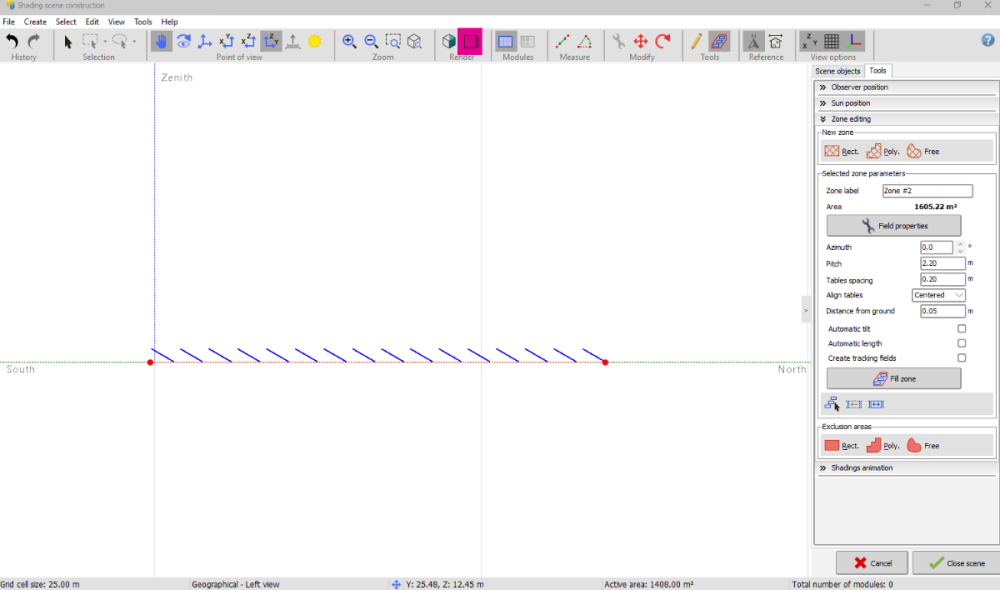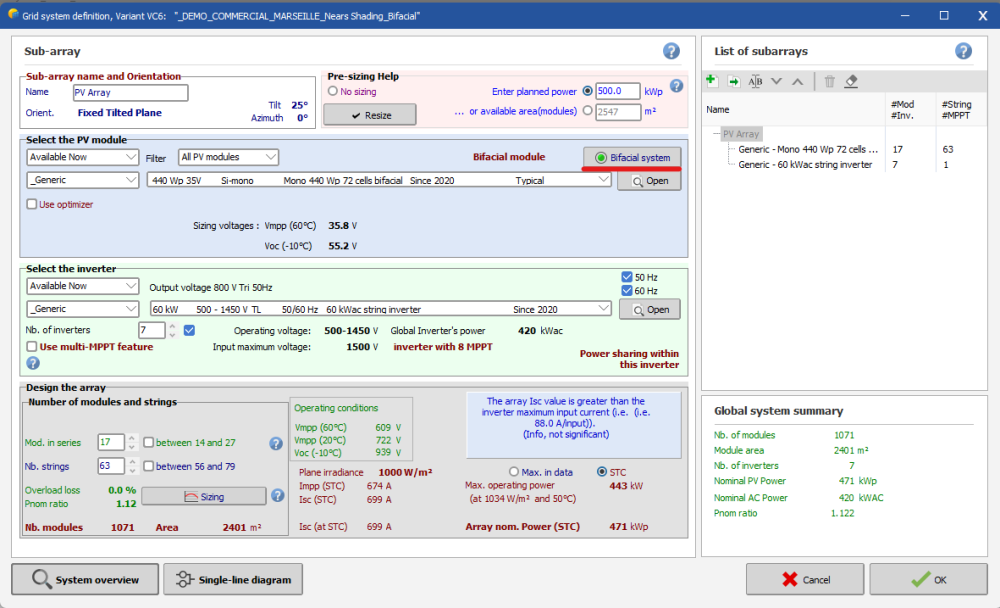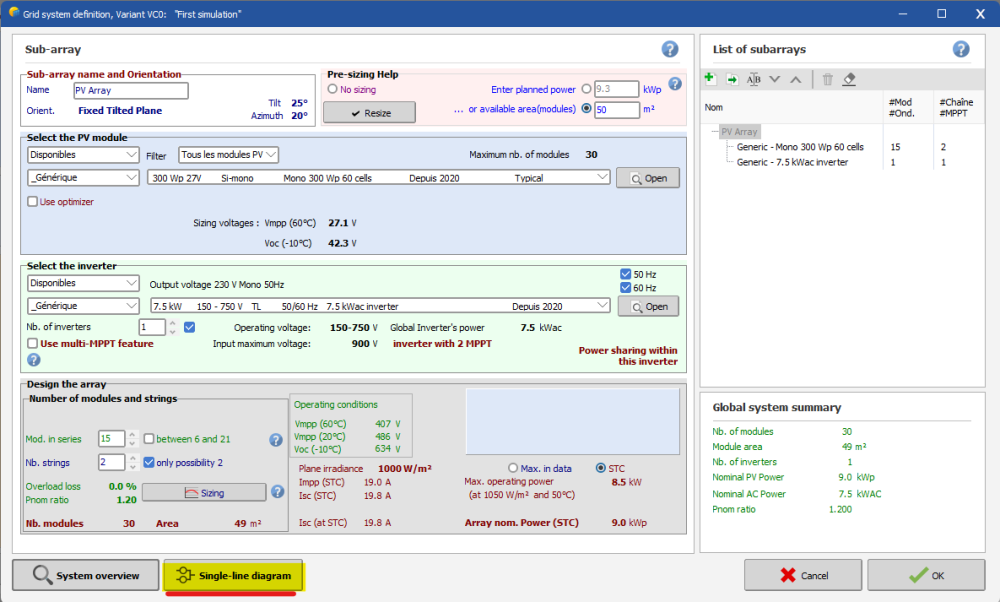-
Posts
211 -
Joined
-
Last visited
Everything posted by Muhammed Sarikaya
-

Different azimuth in Near Shadings and Orientation tabs
Muhammed Sarikaya replied to brunok's topic in How-to
Dear Irakli, Indeed, these values cannot be edited. When working on a project with complex topography in PVsyst, the solar tables installed in the field will often have actual azimuth and tilt values that differ from the expected nominal values. This occurs because the software automatically adjusts each table to the local topography, resulting in natural variations in these angles. Can you confirm that you are working with a topography? Also, could you explain why you want to modify these values? Regards, Muhammed Sarikaya -

Different azimuth in Near Shadings and Orientation tabs
Muhammed Sarikaya replied to brunok's topic in How-to
Dear Irakli, It's possible to change these values. If you select all the tables, your modification will apply to all the selected tables. To modify the tilt, for example, just click in the box where you want to change the value, and it will be applied. Regards, Muhammed Sarikaya -

PVsyst-Main parameters-system-pre-sizing Help
Muhammed Sarikaya replied to Nikoloz's topic in Suggestions
Dear Nikoloz, Thank you very much for your suggestion. I will inform our development team about this feature. Regards, Muhammed Sarikaya -

East West racking with .PVC file
Muhammed Sarikaya replied to solarDG1470's topic in Shadings and tracking
Dear Sarah, In the previous project description, it seems that the PV array consists of fixed-tilt PV tables initially oriented towards the east and west. Due to the topography, the orientation of all tables will change, which is why it results in eight orientations. What you mentioned about the horizontal N-S axis is used for tracking systems. Tracking, horizontal N-S axis: this is the usual configuration of horizontal axis tracking systems. Is this clear enough for you? Please don't hesitate to write to us." Regards, Muhammed Sarikaya -

East West racking with .PVC file
Muhammed Sarikaya replied to solarDG1470's topic in Shadings and tracking
Dear Sarah, I invite you to watch this video to understand how you can import a 3D scene into PVsyst. I don't understand your second question. Could you elaborate and explain what you need clarification on? Regards, Muhammed Sarikaya -

LID + useful life of a photovoltaic module
Muhammed Sarikaya replied to Edwin Tellez's topic in PV Components
Dear Edwin, I can suggest you to read this post: The LID effect only arises with conventional p-type boron-doped wafers. Unconventional technologies using n-type doped wafers (as for example SunPower mono-facial cells) are not affected. LID is a loss of performances arising in the very first hours of exposition to the sun, with Crystalline modules. It may namely affect the real performance with respect to the final factory flash tests data delivered by some PV module providers. This loss is permanent over the entire lifespan of the PV module. Regards, Muhammed Sarikaya -
Dear Irakli, When running in DEMO mode (after the license has expired), you can operate the program and explore all options. You can open existing project files (especially the DEMO projects), view parameter definitions and results, but you cannot save any files. You will only have access to a restricted set of components in the database. If you created a project during the trial license period, you can save your project and continue using it after you purchase the license. Regards, Muhammed Sarikaya
-
Dear Claire, Is it possible for you to send us your project as a zip file to support@pvsyst.com? I need to investigate and understand what the problem is? Regards, Muhammed Sarikaya
-
Dear Claire, In 'orientation,' the method you use to define the position of the PV module will impact the 'global incident in coll. plane.' You probably defined the orientation with a 0° tilt, which is why you are seeing a 0% percentage. Could you please check the orientation and let us know? Regards, Muhammed Sarikaya
-

Define division in modules of every active FV field
Muhammed Sarikaya replied to Alberto Cerrone's topic in Simulations
Dear Alberto Cerrone, Are you using multiple sub-arrays? I encourage you to read this help page: https://www.pvsyst.com/help/multi-mppt_more-examples.htm Regards, Muhammed Sarikaya -

Low system production result
Muhammed Sarikaya replied to Irakli Bezhuashvili's topic in Problems / Bugs
Dear Irakli, PVsyst is not responsible for the actions of its users, and we do not verify whether the results are accurate. We can only investigate in the event of a bug to determine its cause. Additionally, I should mention that the azimuth in your projects appears to be incorrect. Please be aware that an azimuth of 0 in PVsyst corresponds to the direction of the sun. Regards, Muhammed Sarikaya -
Dear MEURVILLE, You must folow this model : You must use the names 'Date,' 'Load,' and '[W]' at the top of the cells so that PVsyst can accept this load profile. Regards, Muhammed Sarikaya
-

Ohmic losses from MV injction point to HV Substation
Muhammed Sarikaya replied to Panagiota's topic in How-to
Dear Panagiota, You can only define losses for MV (medium voltage) transformers and HV (high voltage) transformers. Regards, Muhammed Sarikaya -
Dear Giulio, Unfortenately, we can't see results for every single inverter or subarray. Regards, Muhammed Sarikaya
-
Dear Sir, We update the database using the requests of the manufacturers, and publish it with each new issue of PVsyst. We can't of course follow all the new products of all manufacturers in the world. We don't want to include data without the acknowledgement of the manufacturer. Nevertheless you can easily create your own components by yourself. The easiest way is to choose a similar existing device in the database, modify its parameters according to the manufacturer's datasheets, and save it under a new name, therefore creating a new file in your database. You have a tutorial for that on youtube: https://www.youtube.com/c/PVsystTutos, page Component database Additionally, I invite you to read this page on how to determine IAM values And how to establish pan file: Regards, Muhammed Sarikaya
-
Dear Vera, In your print screen, the bifacial module is not active as the green LED is not illuminated. Here is an example of the bifacial module in use: Regards,
-
Dear Rohit Rana, Could you please send your project to our support email: support@pvsyst.com? We need to investigate why you are experiencing this issue. Regars,
-

Why just some of my pvsyst simulations have unifilar project?
Muhammed Sarikaya replied to Estagiario's topic in Simulations
Dear Estagiario, In the 'System' window, there is a button labeled 'Single-Line Diagram' below. You can click on it to visualize. Regards, Muhammed Sarikaya -
Dear Muhammad, I think you haven't activated 'power sharing' because the buttons in the single-line diagram are not active. Could you please share a complete screenshot of your windows? That way, I can understand better why you're experiencing this problem. Regards,
-
Dear Muhammad Faizen, The reason the SLB (Single Line Diagram) button is inactive is due to the illogical distribution of your modules across the MPPT (Maximum Power Point Tracking) inputs. You are attempting to distribute 7 strings across 5 MPPT inputs. While you can proceed with the simulation, you won't be able to open the "Single Line Diagram". Regards, Muhammed Sarikaya
-

Bifacial Calculation with Fixed structure
Muhammed Sarikaya replied to mohamed abdelkader's topic in Shadings and tracking
Dear Mohamed, You can conduct your project with the panels mounted on a fixed tilt plane. To enable bifacial calculations for a fixed structure system, activate the bifacial model and then select 'Use Unlimited Sheds 2D-Model'. Regards, Muhammed Sarikaya -
Hello, You can only choose from the available cable sections. I suggest selecting the highest section to simulate pessimistic results. Regards,
-

Change in PV loss due to temperature
Muhammed Sarikaya replied to Somasekhar Kodigudla's topic in How-to
Dear Somasekhar, Please read this help page of PVsyst: https://www.pvsyst.com/help/index.html?thermal_loss.htm You will understand the reasons behind the ability to decrease or increase the thermal loss factor. Furthermore, in our YouTube video tutorial, within the "Thermal Behavior" chapter, we explain how you can adjust this parameter. Regards, Muhammed Sarikaya

.png.5a0f08430bae173944a56977dd41765f.png)



